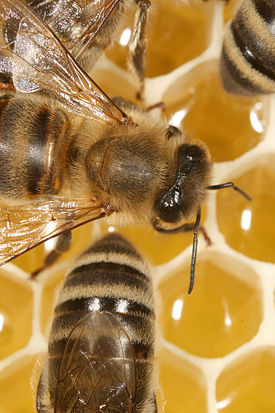蜜蜂舞蹈
蜜蜂舞蹈(英語:waggle dance,蜜蜂8字形搖擺舞)為用於表達蜜蜂養殖行為中之蜜蜂特定8字形舞蹈(figure-eight dance)的一個術語。通過進行這個舞蹈,成功覓食者可以與群體的其他成員分享有關產生花蜜和花粉的花,水源,或以新的巢址位置的方向和距離的信息。[1][2]出自於奧地利生物學家和諾貝爾獎得主卡爾·馮·弗里希在1940年代的研究翻譯其意義,工蜂在採完花蜜回到蜂巢之後,會進行兩種特別的移動方式。[3]研究對象是一種西方蜜蜂、為卡尼鄂拉蜂。當一隻工蜂回到巢中,其他工蜂會面向牠,並以牠為中心,就像在觀看這隻蜜蜂跳舞一樣。在發現提出之後經過多年的爭議,最後被大多數生物學家接受,並且成為當代生物學教科書中有關動物行為的經典教材。



舞蹈的種類
編輯搖臀舞
編輯蜜蜂跳舞的移動路徑會形成一個8字形。外圍環狀部分稱做回歸區(return phase);中間直線部分稱做搖臀區(waggle phase),搖臀舞(Waggle dance)因此得名。蜜蜂會一邊搖動臀部一邊走過這條直線,搖臀的持續時間表示食物的距離,搖臀時間愈長,表示食物距離愈遠,以75毫秒代表100公尺。而這段直線與地心引力的方向之夾角,代表食物方向與太陽方向的夾角。之後更發現,蜜蜂會因太陽位置的相對移動而修正直線的角度。
圓舞
編輯圓舞(Round dance),一開始被分類為另一種舞蹈,是工蜂用來表達蜂巢附近有食物的存在,但無法表達食物的距離與方向。通常使用在發現近距離的食物(距離小於50-60公尺)。然而後來的研究認為環繞舞並非獨立存在,而是搖臀舞的直線部分極短暫的版本。
搖擺舞交流演化
編輯科學家透過觀察發現不同品種的蜜蜂擁有不同舞蹈的「語言」,每個品種或亞種舞蹈的弧度及時間都各有不同[4][5]。一項近期研究顯示在東方蜜蜂及西方蜜蜂共同居住的地區,二者能夠逐漸理解對方舞蹈中的「語言」[6]。
參見
編輯資料來源
編輯- ^ J. R. Riley, U. Greggers, A. D. Smith, D. R. Reynolds, R. Menzel. The flight paths of honeybees recruited by the waggle dance. Nature. 2005/05, 435 (7039): 205–207 [2018-04-02]. ISSN 1476-4687. doi:10.1038/nature03526. (原始內容存檔於2021-03-08) (英語).
- ^ Seeley T.D., Visscher P.K., Passino K.M. Group decision making in honey bee swarms. American Scientist. 2006, 94: 220–229. doi:10.1511/2006.3.220.
- ^ Frisch, Karl von. (1967) The Dance Language and Orientation of Bees. Cambridge, Mass.: The Belknap Press of Harvard University Press.
- ^ Gould J, Towne W (1987) The evolution of the dance language. American Naturalist 130: 317–338.
- ^ Dyer FC, Seeley TD (1991) Dance dialect and foraging range in three Asian honeybee species. Behavioral Ecology and Sociobiology. 28: 227–233.
- ^ Su S, Cai F, Si A, Zhang S, Tautz J, et al. (2008) East Learns from West: Asiatic Honeybees Can Understand Dance Language of European Honeybees. PLoS ONE Volume 3, Number 6: e2365 doi:10.1371/journal.pone.0002365 [1] (頁面存檔備份,存於互聯網檔案館)
參考文獻
編輯- Neil A. Campell, Jane B. Reece (2002) BIOLOGY 6th Edition 1143-1144
- Gould, J. L. (1975) Honey bee recruitment: the dance-language controversy. Science 189, 685−693.
- Riley, J.R., Greggers, U., Smith, A.D., Reynolds, D.R. & Menzel, R. (2005). The flight paths of honeybees recruited by the waggle dance. Nature 435,205-207.
- Seeley, T.D. (1995) The Wisdom of the Hive. Cambridge, MA: Harvard University Press.
- von Frisch, K. (1967) The Dance Language and Orientation of Bees. Cambridge, MA: Harvard University Press.
延伸閱讀
編輯- Gould JL. Honey bee recruitment: the dance-language controversy. Science. 1975, 189 (4204): 685−693. Bibcode:1975Sci...189..685G. doi:10.1126/science.1154023.
- Riley JR, Greggers U, Smith AD, Reynolds DR, Menzel R. The flight paths of honeybees recruited by the waggle dance. Nature. 2005, 435 (7039): 205–207. Bibcode:2005Natur.435..205R. PMID 15889092. doi:10.1038/nature03526.
- Seeley TD. The Wisdom of the Hive. Cambridge, MA: Harvard University Press. 1995.
- von Frisch K. The Dance Language and Orientation of Bees. Cambridge, MA: Harvard University Press. 1967.
- Rendell, L; Boyd, R., Cownden, D, Enquist, M., Eriksson, K., Feldman, W. M., Fogarty, L., Ghirlanda, S., Lilicrap, T., adn Laland, K. N. Why copy others? Insights from the social learning strategies tournament. Science. 2010, 328: 208–213. doi:10.1126/science.1184719.
- Gruter, C; Ratnieks, F. L. Honeybee foragers increase the use of waggle dance information when private information becomes unrewarding. animal behavior. 2011, 81: 949–954 [2013-12-28]. (原始內容存檔於2019-12-21).
- Dyer, F. C. The biology of the dance language. Annual reviewi of entomology. 2002, 47: 917–949. doi:10.1146/annurev.ento.47.091201.145306.
- Beekman, M.; Golag, R. S., Even, N. Wattanchiyingchareon, W., and Olroyd, B. P. Dance precision of Apis florae--clues to the evolution of honeybee dance language. Behavioral Ecology and Sociobiology. 2008, 62: 1259–1265. doi:10.1007/s00265-008-0554-z.
- Al Toufalia, H. M. Honey bee foraging: persistence to non-rewarding feeding locations and waggle dance communication. Doctoral thesis, University of Sussexx. 2012 [2013-12-28]. (原始內容存檔於2022-05-17).
外部連結
編輯- Waggle Dance Infographic (頁面存檔備份,存於互聯網檔案館) - VetSci
- Communication and Recruitment to Food Sources by Apis mellifera — 美國農業部-ARS (accessed 2005-03)
- Honeybee Communication — Kimball's Biology Pages (accessed 2005-09)